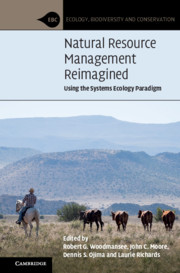Book contents
- Natural Resource Management Reimagined
- Ecology, Biodiversity and Conservation
- Natural Resource Management Reimagined
- Copyright page
- Contents
- Contributors
- Preface
- 1 The Systems Ecology Paradigm
- 2 Environmental and Natural Resource Challenges in the Twenty-First Century
- 3 Evolution of Ecosystem Science to Advance Science and Society in the Twenty-First Century
- 4 Five Decades of Modeling Supporting the Systems Ecology Paradigm
- 5 Advances in Technology Supporting the Systems Ecology Paradigm
- 6 Emergence of Cross-Scale Structural and Functional Processes in Ecosystem Science
- 7 Evolution of the Systems Ecology Paradigm in Managing Ecosystems
- 8 Land/Atmosphere/Water Interactions
- 9 Humans in Ecosystems
- 10 A Systems Ecology Approach for Community-Based Decision Making
- 11 Environmental Literacy
- 12 Organizational and Administrative Challenges and Innovations
- 13 Where to From Here? Unraveling Wicked Problems
- Index
- References
5 - Advances in Technology Supporting the Systems Ecology Paradigm
Published online by Cambridge University Press: 25 February 2021
- Natural Resource Management Reimagined
- Ecology, Biodiversity and Conservation
- Natural Resource Management Reimagined
- Copyright page
- Contents
- Contributors
- Preface
- 1 The Systems Ecology Paradigm
- 2 Environmental and Natural Resource Challenges in the Twenty-First Century
- 3 Evolution of Ecosystem Science to Advance Science and Society in the Twenty-First Century
- 4 Five Decades of Modeling Supporting the Systems Ecology Paradigm
- 5 Advances in Technology Supporting the Systems Ecology Paradigm
- 6 Emergence of Cross-Scale Structural and Functional Processes in Ecosystem Science
- 7 Evolution of the Systems Ecology Paradigm in Managing Ecosystems
- 8 Land/Atmosphere/Water Interactions
- 9 Humans in Ecosystems
- 10 A Systems Ecology Approach for Community-Based Decision Making
- 11 Environmental Literacy
- 12 Organizational and Administrative Challenges and Innovations
- 13 Where to From Here? Unraveling Wicked Problems
- Index
- References
Summary
The systems ecology paradigm could not have developed without advances in computer science, chemical analysis, microscopy, remote sensing and telemetry, geographic information systems, and information management systems. In the late 1960s, mainframe computers occupying entire rooms and buildings cranked out calculations at speeds that pale in comparison to today’s smart phones, laptop, and desktop computers. Chemical analyses were accomplished primarily using wet chemistry. The ability to “see” inside soil particles has evolved from the desktop microscope to computer imaging. With modern spectroscopy and imaging both precision and accuracy have advanced exponentially. Remote sensing was conducted using photography from airplanes, towers, and ladders. Now we have high-resolution imaging, and spectral imaging, from satellites, manned aircraft, and drones. Geographic information systems have developed from paper maps to powerful technologies manipulating and displaying massive amounts data on handheld devises, laptops, and desktop computers. Information management has moved from data storage on paper files to digital and searchable storage available from almost anywhere on earth. Now, all of these technologies are interconnected through digital networks used by systems ecologists. Systems ecologists have both adopted and developed new technology and these advances have gone hand-in-hand with conceptual change.
Keywords
- Type
- Chapter
- Information
- Natural Resource Management ReimaginedUsing the Systems Ecology Paradigm, pp. 131 - 139Publisher: Cambridge University PressPrint publication year: 2021



